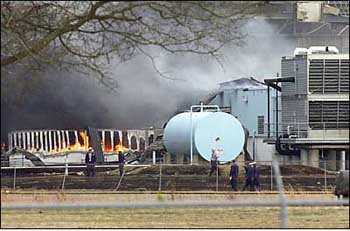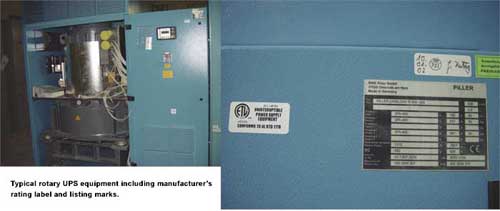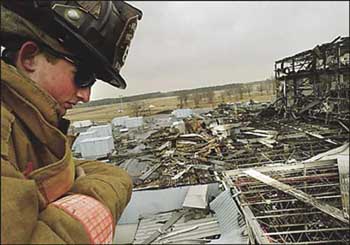There are many elements to electrical safety in the workplace. The entire process for each company is ultimately the responsibility of several key people or groups of people who will be involved at different times. First, there is the owner who needs certain things to happen, in an organized manner, including everything that will need to be in the facility. Next, architects help bring the idea to life, and give the buildings shape and definition. After this, the engineering firm designs the electrical systems needed, and specifies the safety considerations based on the activity that will take place in a particular area or room. After this, the plans reviewer verifies that the engineering plans conform to the local codes and the NEC. When this step is complete, the plans reviewer passes the baton to the building and electrical inspectors. But it does not end here…this is just the beginning.
Next, the equipment necessary for the production of the end product is ordered and delivered, then installed. Let’s say the end product is a manufactured good, and the equipment will be for production lines and support systems processes. Many plans reviewers ask questions about specific equipment and systems that will be installed, to head off any unknowns. Gary Mullis, electrical plans examiner for Mecklenburg County in North Carolina puts it this way: “I ask the owners and engineers if the equipment is listed and labeled, if the environment complies with the listing, and then inform them that it is illegal to install unlisted equipment after the certificate of occupancy (CO) is issued. If their equipment does not comply, we offer them a program for approved field certifications by electrical recognized testing labs. This improves our time lines in meeting customer demands and insuring the public’s safety, making the process run smoothly, and gives the electrical inspector the information he needs as well as what the contractor/installer needs.”
NFPA 70E comes into play somewhere in here, after the initial design and inspection of this manufacturing plant. The writers of 70E intended that “It’s provisions should give protection to the employee from electrical hazards,” and that “The provisions should not be encumbered with unnecessary details, and that they must not add any requirements not found in the NEC. NFPA 70E ….. is intended for use by employers, employees and OSHA.”1 Here are the weak links in the chain: (1) employers buy equipment that has never been certified by a nationally recognized testing laboratory, and may not have adequate installation instructions; (2) employees must work with and service this questionable equipment, and (3) OSHA rarely comes to inspect. When they do, they do not verify that equipment meets the minimum levels of electrical safety specified by product safety standards.

Photos 1. Explosive dust
What NFPA 70E doesn’t say?
It does not mention that U.S. federal law requires all electrical equipment in employee workplaces to be certified for electrical safety by a nationally recognized testing laboratory. Is this an “unnecessary detail” as written in the 70E foreword? Without this, are employees really “protected from electrical hazards”? Do their facility insurance providers know this?

Photo 2. Typical rotary UPS equipment including manufacturer’s rating label and listing marks
In a recent position letter, Richard Fairfax, OSHA’s head of the Directorate of Compliance Programs, states clearly, “Therefore equipment must be listed, labeled, or certified by a NRTL (nationally recognized testing laboratory). As we understand the conversation of my staff and you, the equipment was not certified by NRTL, it is a violation of OSHA standard 1910.399 (a)(1).” (This document can be located on the OSHA websitewww.osha.gov, by placing 1910.399 in the “Search” field. You will see the standard interpretation under the title “Review of electrical schematic diagrams, OSHA does not approve equipment designs.”)
In the scope of 70E, the first mention of electrical equipment is in 1-1.1(1), stating that the standard covers “Electric conductors and equipment installed within or on buildings or other structures….” In the definition of approved, testing laboratories are mentioned, but no reference to the NRTL program is made. Most states and jurisdictions use the OSHA NRTL list to determine laboratory acceptability and equipment evaluation categories. Authorities having jurisdiction (AHJ) do not maintain the hundreds of product safety standards needed to inspect and evaluate equipment, and can rely on their NRTL product safety experts to assist. To provide more guidance to our electrical inspectors, it may be helpful to refer to the OSHA NRTL list available on the internet. Go towww.osha.gov, then select “N” from the alphabetical index. The nationally recognized testing laboratory link will come up, and from there you can look at the list of approved testing laboratories, their approved product categories, and even examples of their certification and labeling marks. (In North Carolina, Oregon, Washington, city of Los Angeles, California, and a few other areas, you will need to refer directly to individual lists of approved/accredited testing laboratories.)
The 70E definition of electrical safety is “Recognizing hazards associated with the use of electrical energy and taking precautions so that hazards do not cause injury or death.” Let’s return to our example of the manufacturing facility, and suppose that the product being manufactured requires a process that creates explosive dust buildup in a room or area. This would require any equipment installed in that area to meet the requirements for Hazardous Location, Class II, Division 1. Class II, Division 1 anticipates that this buildup will occur, and that the equipment should not be capable of igniting the dust. Ask yourself some questions:
- How would an employer, employee, electrical inspector or OSHA inspector verify the suitability of this equipment?
- How would they recognize the hazards posed by this equipment? Would the purchasing department of the company inspect the incoming equipment for compliance to the applicable standards?
- Would an OSHA inspector have and refer to copies of NFPA 496 or UL 698A, then spend several hours performing a thorough evaluation and specifying modifications to bring the equipment into compliance?
Unfortunately, the answers to these questions are “Maybe,” and “Probably not,” or “Highly unlikely.” This leaves the possibility that the equipment could cause an explosion, possibly resulting in fire and worker deaths, not to mention the loss of millions of dollars and other economic fallout from displaced workers and potential environmental damage. When it comes to equipment, the best way of “taking precautions so that hazards do not cause injury or death,” is making sure an approved testing laboratory has certified the equipment, either at the equipment manufacturer’s location, or in an on-site field evaluation at the workplace installation.
In Part 1 of 70E, guidelines are described for installation safety requirements. Many of these guidelines are applicable to installation of building and facility wiring, and 70E is a very useful and well-written document for these purposes. With regards to installed electrical equipment, several areas touch on important aspects of safety of electrical products and systems. A note for judging the suitability of equipment being examined includes the wording “…may be identified by a description marked on or provided with a product to identify suitability of the product for a specific purpose, environment or application. Suitability may be evidenced by listing or labeling.” Does this mean that an employer, employee or OSHA inspector could accept a product marked with a CE sticker? 2 It is important to consider that a CE label can be placed on anything by anybody, and does not have to comply with any U.S. requirements for electrical product safety. In fact, most manufacturers who “”self-certify”” their equipment do not even meet the CE requirements, and fall well short of the U.S. safety requirements. If you have ever seen a CE “Declaration of Conformity,” you would have seen that U.S. standards are not even mentioned. Some of these documents only contain reference to European Union (EU) Directives, and requirements for electromagnetic compatibility. In the U.S. and Canada, product safety electrical testing is an essential element of product certification, and is the only way to identify some potentially catastrophic electrical hazards. The CE label or documents provide no assurance that any testing has been performed.

Photo 3. Aftermath
“Suitability may be evidenced by listing or labeling.” Perhaps “should be” or “needs to be” would be better. Maybe it should read, “If you do not consider listing or labeling by a nationally recognized testing laboratory in determining the suitability and electrical safety of your equipment, you might be making a big mistake.” In equipment listed by an NRTL, items in sections like: Integrity of Electrical Equipment and Connections (1-3.7.3), Live Parts Guarded Against Accidental Contact (1-8.2.1), Guarding (2-4.2.1), and Warning Signs (2-4.2.2), are addressed by the listing or labeling of the certified product. In Chapter 3 Wiring Methods, 3-1 states that, “The provisions of this chapter shall not apply to the conductors that are an integral part of factory-assembled listed equipment.” So, what about the thousands of pieces of equipment that are not listed? What about systems that are assembled on-site? What about custom-built equipment? Is Chapter 3 of 70E intended to replace the wiring method evaluation to U.S. product safety standards that are performed by trained electrical product safety professionals? This is a huge burden to place on an employer or employee, or an OSHA inspector. Should they be expected to evaluate an industrial system to NFPA 79? What about a paint booth, with its multiple-standard evaluation needs?
An example from Chapter 4 is useful for illustration of this point. 4.6.2 Control – Industrial and Commercial Laboratory Equipment: “All radiographic- and fluoroscopic-type equipment shall be effectively enclosed or shall have interlocks that de-energize the equipment automatically to prevent ready access to live current-carrying parts.” Listed equipment already meets this requirement, and field labeled equipment will meet these requirements after an evaluation to U.S. product safety standards. In this case, the applicable standard is UL 61010A. In the product safety certification or field evaluation process, the testing laboratory will work directly with the manufacturer, ensuring that the needed modifications are completed, and that the equipment will function properly. Without this testing laboratory interaction, the employer is left to attempt the management of this process. Records of field evaluations performed on this kind of equipment show that modifications are not always performed correctly, even though the manufacturer may estimate that the changes are complete. Often, modifications must be performed again after the initial information is reviewed. Would an OSHA inspector manage this process? Would they be familiar with the electrical construction and testing requirements of UL 61010A?
NFPA 70E defines an electrical hazard as “A dangerous condition such that contact or equipment failure can result in electric shock, arc flash burn, thermal burn, or blast.” In reviewing the field evaluation reports from our substantial files, one fact became evident: 100 percent of non-certified equipment installed in hazardous locations reviewed under the field evaluation program failed to meet the level of safety during our first engineering visit.
Again, let’s consider our manufacturing plant, and suppose that one area in the plant contains Class E ignitable dust where the process anticipates an occasional buildup. That would suggest a Class II, Division 1 classification for hazardous location. NFPA 70E is correct in advising that electrical equipment not be present in these areas; however, with today’s technology this is not always possible. The equipment installed in this area would need to meet the requirements for this classification. If a system or piece of equipment was not listed or labeled by an approved testing laboratory, how would these requirements be verified? Who would be qualified? An employee? An OSHA inspector? A county building official? Failure to meet and verify these requirements for an established minimum level of safety represents an explosion hazard, fire hazard, loss of life hazard and an overall disaster from which there would be no recovery. Still, every day, in many parts of the country, the odds are played, and the odds are not good. In most cases, employees are not even aware that their lives and livelihoods are being played against these unknown chances, sometimes for the fear that an employer may have to spend a few thousand dollars to have equipment certified. How much are these lives worth?
Parts 2 and 3 of NFPA 70E have critical and well-written safety practices and maintenance requirements that, when followed, will help prevent electrical accidents and hazards. With regards to listed and labeled equipment, these guidelines may help to assist the employer and employees in ensuring that this certified equipment is not modified in such a manner that would create a hazard. NFPA 70E will play an important role in workplace safety, especially in these regards, including the necessary guidance needed for personal protective equipment and procedures to follow when maintenance and repair work is required for electrical equipment and systems.
Since NFPA 70E does not say it, anyone using this standard should be reminded of the role played by the nationally recognized testing laboratories, accredited by OSHA. The services available by these electrical product safety specialists will be invaluable in meeting these requirements, especially in Part 1. The fact that the NRTL testing laboratories and the OSHA NRTL program is not even mentioned, may be an omission of great consequence.
1 NFPA 70E – 2000, Foreword. (National Fire Protection Association, Quincy, MA).
2 The CE mark indicates that a product complies with all the European Product Directives that apply to it when being placed on the market or being put into service for the first time in the European Economic Area (EEA).














Find Us on Socials